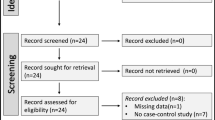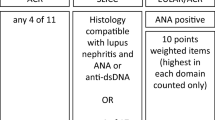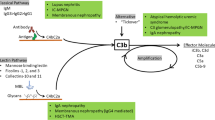Abstract
The objective was to investigate the frequency of anti-cyclic citrullinated peptides (CCP) antibodies in systemic sclerosis (SSc) and primary biliary cirrhosis (PBC), utilizing a new “third generation” anti-CCP ELISA (anti-CCP3) kit and a conventional anti-CCP2 assay. Patients with PBC, SSc, RA, and normal controls were included in the study. Serum samples were screened for autoantibodies by indirect immunofluorescence (IIF), antibodies to CCP by a second- and third-generation ELISA, antibodies to “scleroderma” antigens (CENP B, Scl-70, PM/Scl and fibrillarin—Scl-34) by a line immunoassay (LIA), and IgM RF by ELISA. The frequency of anti-CCP2 antibodies in SSc and PBC samples was 14.8% (11/74) and 6.2% (5/80), respectively, and the frequency of anti-CCP3 antibodies in SSc was 13.5% (10/74) and in PBC was 3.7% (3/80). By comparison, in the RA group the frequency of anti-CCP3 and anti-CCP2 antibodies was 79.1% (38/48) and 77% (37/48), respectively. Anti-CCP3 ELISA had a sensitivity, specificity, and positive and negative likelihood ratios (LR) of 79% (95% confidence interval [CI] = 64–89%), 93% (95% CI = 88–96%), 11.8 (95% CI = 6.8–20.3), and 0.22 (95% CI = 0.12–0.38), respectively. By comparison, the anti-CCP2 assay had a sensitivity, specificity, and positive and negative LRs of 77% (95% CI = 62–87), 90% (95% CI = 85–94), 8.3 (95% CI = 5.2–13.2), and 0.25 (95% CI = 0.15–0.42), respectively. In patients with SSc, there was an association of anti-CCP2 antibodies with the presence of arthritis, but there was no association of anti-CCP2 or anti-CCP3 with anti-CENP B, anti-Scl 70, or RF. This study confirmed the high specificity and sensitivity of both anti-CCP assays for the diagnosis of RA. The presence of anti-CCP antibodies in SSc was only correlated with the presence of arthritis.


Similar content being viewed by others
Abbreviations
- ALBIA:
-
Addressable laser bead immunoassay
- CCP:
-
Cyclic citrullinated peptide
- ELISA:
-
Enzyme linked immunoassay
- PBC:
-
Primary biliary cirrhosis
- RA:
-
Rheumatiod arthritis
- SPSS:
-
Statistical package for the Social Sciences
- SSc:
-
Systemic sclerosis
- SSN:
-
Serum sample number
- U:
-
Units
References
Paulus HE, Wiesner J, Bulpitt KJ, et al (2002) Autoantibodies in early seropositive rheumatoid arthritis, before and during disease modifying antirheumatic drug treatment. J Rheumatol 29:2513–2520
Goldbach-Mansky R, Lee J, McCoy A, et al (2000) Rheumatoid arthritis associated autoantibodies in patients with synovitis of recent onset. Arthritis Res 2:236–243
Nell VPK, Machold KP, Stamm TA, et al (2005) Autoantibody profiling as early diagnostic and prognostic tool for rheumatoid arthritis. Ann Rheum Dis 64:1731–1736
Avouac J, Gossec L, Dougados M (2006) Diagnostic and predictive value of anti-cyclic citrullinated protein antibodies in rheumatoid arthritis: a systematic literature review. Ann Rheum Dis 65:845–851
Zendman AJ, Van Venrooij WJ, Pruijn GJ (2006) Use and significance of anti-CCP autoantibodies in rheumatoid arthritis. Rheumatology (Oxford) 45:20–25
Menard HA (2007) Anti-CCP versus anti-Sa antibodies for the diagnosis of RA. Nat Clin Pract Rheumatol 3:76–77
Scheuer PJ (1967) Primary biliary cirrhosis. Proc R Soc Med 60:1257–1260
Scheuer PJ (1988) Ludwig Symposium on biliary disorders—part II. Pathologic features and evolution of primary biliary cirrhosis and primary sclerosing cholangitis. Mayo Clin Proc 73:179–183
Miyachi K, Hirano Y, Horigome T, et al (2004) Autoantibodies from primary biliary cirrhosis patients with anti-p95c antibodies bind to recombinant p97/VCP and inhibit in vitro nuclear envelope assembly. Clin Exp Immunol 136:568–573
Miyachi K, Hankins RW, Matsushima H, et al (2003) Profile and clinical significance of anti-nuclear envelope antibodies found in patients with primary biliary cirrhosis: a multicenter study. J Autoimmun 20:247–254
Arnett FC, Edworthy SM, Bloch DA, et al (1988) The American Rheumatism Association 1987 revised criteria for the classification of rheumatoid arthritis. Arthritis Rheum 31:315–324
Fritzler MJ, Miller BJ (1995) Detection of autoantibodies to SS-A/Ro by indirect immunofluorescence using a transfected and overexpressed human 60 kD Ro autoantigen in HEp-2 cells. J Clin Lab Anal 9:218–224
Selak S, Woodman RC, Fritzler MJ (2000) Autoantibodies to early endosome antigen (EEA1) produce a staining pattern resembling cytoplasmic anti-neutrophil cytoplasmic antibodies (C-ANCA). Clin Exp Immunol 122:493–498
Eystathioy T, Chan EKL, Yang Z, et al (2003) Clinical and serological associations of autoantibodies to a novel cytoplasmic autoantigen, GW182 and GW bodies. J Mol Med 81:811–818
Nakamura M, Kondo H, Mori T, et al (2007) Anti-gp210 and anti-centromere antibodies are different risk factors for the progression of primary biliary cirrhosis. Hepatology 45:118–127
Fritzler MJ, Valencia DW, McCarty GA (1984) Speckled pattern antinuclear antibodies resembling anticentromere antibodies. Arthritis Rheum 27:92–96
Fritzler MJ, Hanson C, Miller J, Eystathioy T (2002) Specificity of autoantibodies to SS-A/Ro on a transfected and overexpressed human 60 kDa Ro autoantigen substrate. J Clin Lab Anal 16:103–108
Ingegnoli F, Galbiati V, Zeni S, et al (2006) Use of antibodies recognizing cyclic citrullinated peptide in the differential diagnosis of joint involvement in systemic sclerosis. Clin Rheumatol 26:510–514
Fritzler MJ, Manns MP (2002) Anti-mitochondrial antibodies. Clin Appl Immunol Rev 3:87–113
Fusconi M, Berti CC, Monti G, et al (1996) Antikeratin antibodies (AKA) negativity in primary biliary cirrhosis (PBC): confirmation of their specificity in the diagnosis of rheumatoid arthritis (RA). Clin Rheumatol 15:617–618
Fusconi M, Vannini A, Dall’Aglio AC, et al (2005) Anti-cyclic citrullinated peptide antibodies in type 1 autoimmune hepatitis. Aliment Pharmacol Ther 22:951–955
Makinen D, Fritzler MJ, Davis P, Sherlock S (1983) Anticentromere antibodies in primary biliary cirrhosis. Arthritis Rheum 26:914–917
Bombardieri M, Alessandri C, Labbadia G, et al (2004) Role of anti-cyclic citrullinated peptide antibodies in discriminating patients with rheumatoid arthritis from patients with chronic hepatitis C infection-associated polyarticular involvement. Arthritis Res Ther 6:R137–R141
Wener MH, Hutchinson K, Morishima C, Gretch DR (2004) Absence of antibodies to cyclic citrullinated peptide in sera of patients with hepatitis C virus infection and cryoglobulinemia. Arthritis Rheum 50:2305–2308
Matsui T, Shimada K, Ozawa N, et al (2006) Diagnostic utility of anti-cyclic citrullinated peptide antibodies for very early rheumatoid arthritis. J Rheumatol 33:2390–2397
Acknowledgments
The authors acknowledge the technical assistance of Jane Zhang and Mark Fritzler. This study was supported by grants #38034 and #10884 from the Canadian Institutes of Health Research. MJF holds the Arthritis Society Research Chair at the University of Calgary, and funds from this endowment supported the sabbatical leave of MS. MS also received a scholarship from CAPES—Coordenação de Aperfeiçoamento de Pessoal de Nível Superior. Diagnostic kits for CCP3, gp210, and rheumatoid factor were generous gifts of INOVA Diagnostics, San Diego, CA. HEp-2 kits were a gift of ImmunoConcepts Inc., Sacramento, CA.
Conflict of Interest Statement
Mittermayer Santiago: none
Murray Baron: none
Kiyomitsu Miyachi: none
Canadian Scleroderma Research Group: none
Marvin Fritzler: is a paid consultant of ImmunoConcepts Inc. (Sacramento, CA)
Author information
Authors and Affiliations
Corresponding author
Rights and permissions
About this article
Cite this article
Santiago, M., Baron, M., Miyachi, K. et al. A comparison of the frequency of antibodies to cyclic citrullinated peptides using a third generation anti-CCP assay (CCP3) in systemic sclerosis, primary biliary cirrhosis and rheumatoid arthritis. Clin Rheumatol 27, 77–83 (2008). https://doi.org/10.1007/s10067-007-0656-4
Received:
Revised:
Accepted:
Published:
Issue Date:
DOI: https://doi.org/10.1007/s10067-007-0656-4




